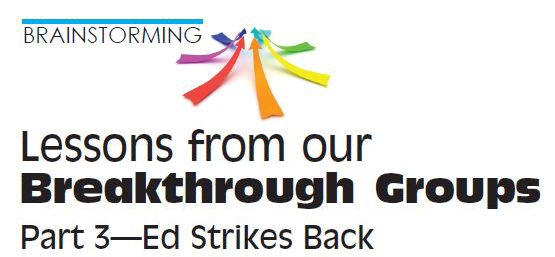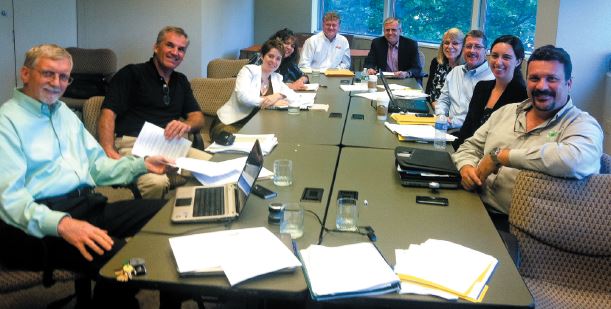Written on: August 12, 2012 by Ed Cardell
 Talking with people in our industry lately has got me thinking back to when I was a kid. I would come home whining to my dad about the trials of youth. “I got benched today, Dad” or “I can’t spin the oil filter off my car” or “She dumped me,” I’d say. (By the way, that last one happened a lot.) Dad would always respond with “So what are you going to do about it?”
Talking with people in our industry lately has got me thinking back to when I was a kid. I would come home whining to my dad about the trials of youth. “I got benched today, Dad” or “I can’t spin the oil filter off my car” or “She dumped me,” I’d say. (By the way, that last one happened a lot.) Dad would always respond with “So what are you going to do about it?”
I always remembered these words when I was general manager of the fuel division of one of the country’s most diversified energy and residential services companies. They ring just as true now that I’m consulting with energy companies across the country.
The challenges we face are BIG. There is no shortage of reasons why it’s so difficult to succeed in today’s market. The key question remains, “What are you going to do about it?” And while there are good solutions, you don’t always find them within your own company.
Frankly Speaking
When I first attended a Warm Thoughts Breakthrough Group meeting, I was struck by how different they were from a typical association gathering. I know. I was President of the Del Val Oilheat Dealers Association not once, but twice (some people might think I’m a glutton for punishment). There is a different level of frankness, because there are no competitors present. And people only join these groups when they are really interested in accelerating their learning curve and finding more innovative solutions—and sharing their experiences—warts and all. By the same token, now that I’m moderating some of these groups, I’ve been struck by how many innovative things different companies are doing. Each company seems to have its hands around a few things that are really smart. When you combine all that together, it can be very valuable.
Breakthrough Groups always start off with a series of questions: What are the most difficult challenges you are facing today? What are you doing about it? What’s working and what’s not? At a recent meeting focused on sales and customer service strategies, a bunch of interesting things came up. Here are a few:
 Improving Sales Performance
Improving Sales Performance
Want to make your day less happy? Mysteryshop your company. We made calls to our member’s companies pretending to be interested in an air conditioning tune up. In 70% of the cases, the person answering the phone gaffed in some major way.
Remember the old adage; never quote price before showing value. Guess what? In 75% of the cases, when we called as a prospective oil customer and asked, “What’s your price?” the person on the phone simply quoted a number. When we said, “Thanks,” they said, “Have a nice day.” Lessons from our Breakthrough Groups Part 3—Ed Strikes Back 22
You cannot win with this approach, unless you are the lowest priced company, or you are too busy to sell service. Your people are so bombarded with price shoppers that they treat everyone as if they are going to hang up right away. They treat everyone like coal, so they miss the diamonds. Rather than spending twice as much to generate more leads, get the right salesmanship happening at your company.
Where do I go to find a good inside sales candidate in today’s market?
Think outside the box when hiring your next rep. We are seeing great levels of success hiring fuels sales reps from outside the industry. One of our members picked up a new salesman from Service Master. He’s lit their world on fire, in part because he was already well trained on selling service plans and programs. Another member, who also brought me in to do sales training for his team, recently scored with a former Owens Corning salesman. Maybe it’s because these guys have a good understanding of how to compare pricing options, or because they’ve learned to succeed in a hyper competitive market, but this sales rep is also lighting it up. And these guys have no hesitation about making outbound calls and “Dialing for Dollars.”
Getting the Compensation Mix Right. Salary vs. Commission?
If you have salesmen who are getting mostly salary rather than mostly commission, you would do well to reconsider. When this question was raised recently, the consensus was clear. Every company that moved to a commission heavy structure for either equipment sales or new fuel account sales saw a nice increase in sales. Every single one.
Are you paying people some type of retained gallons agreement? Do they get paid a penny or two on the gallons their customers continue to buy? Our Breakthrough Group members would say “save the money.” These programs are designed to get salesmen focused on retention or build some ongoing handcuffs. But the truth is, the individual customer is still not worth enough for the salesman to modify his ongoing activities and do proactive retention. Spend the money instead on a monthly bonus structure that escalates their pay when they hit their monthly goals. The trick is to impact on their behavior every month. If they are going to have retention responsibilities, that’s what a partial salary is for. There are some companies however, that are starting to provide spiffs for keeping customers who had called to cancel, as well.
Focus on quality
While the details vary considerably from one company to another, there is one constant: fuel commission schedules are tiered and based on the value of the account signed. Did the rep bring in a service agreement, EFT, EZ Pay Plan, automatic delivery, etc.? There’s different compensation for each.
But different incentives are not enough. Nothing beats tight management. An automatic account on a fixed price is much more likely to leave after a year than an automatic/budget/service plan/EFT. Over time, this has a HUGE impact on the profitability of your business. So, do you track the quality of accounts and set goals? Do you train them to “sell the package”? Are your customer incentives structured to support this?
Once you’ve hooked them, get them in the boat.
In one of our groups, we benchmarked whether customer losses followed particular patterns and what should be done about it. Sure enough, the most substantial drop off occurred in years one and two. Seems like common sense, but it is riveting to see the actual numbers and calculate the impact over time.
The rent-a-customer syndrome has to do with the nature of today’s “shopper” customers, and also the way many new customer deals are structured. Regardless, if you can get them to stay with you for three years or more, you’re much more likely to keep them for many more years to come. So how do you impact this “magic period” to increase the likelihood of retention? What is your strategy to retain them? Do you have a new customer integration process in place?
The ideas about this vary, but everyone agreed it makes sense to focus special attention and resources on this “magic period.” One company designed a very cool “welcome packet” to make a good first impression. They followed that with a “How are you doing?” call, which also gave them an opportunity to try to upgrade customers to some additional service and ask for referrals. They sent a customer survey. They partnered with some local companies to give customers a discount at movie theaters and restaurants. They kept track of when their “new customer deal” ended and made another contact before it expired. This was on top of their regular communications, like newsletters, e-letters, etc.
One company did some investigation and found that rather than jump the customer up to their regular price after their deal was over, it made more sense financially to give them something—½ off an air conditioning service plan, a lower price cap fee, a couple of $25 coupons. The trick is actually starting to track your losses carefully and the impact of such offers. Sometimes, this “step down” approach is justified, especially in very competitive markets. In other cases, you’d be better off saving that pool of money for the smaller percentage of customers who really need something more to stay.
When you consider the “all-in,” the cost of signing a new account is easily between $500 and $800 in most places; spending some to get them over the two-year hump can be very productive (even if it feels like you shouldn’t have to do it.)
Somewhere in this collection of stones, I hope you found a gem: a concept or process that you can implement today, a reminder of something you already knew or did that may have slipped from your focus, or simply an incentive to act. I look forward to bringing you more Breakthrough Group insights in future issues. Together, let’s do something about it. Let’s make great things happen in 2012-13.